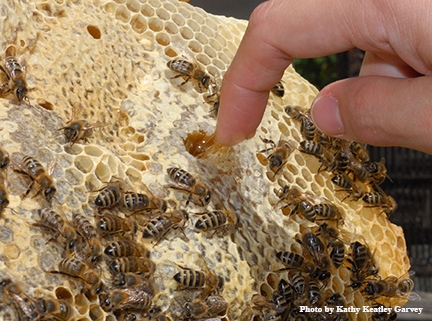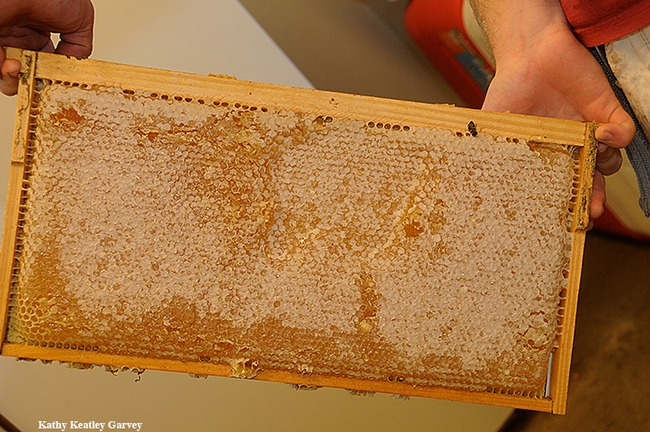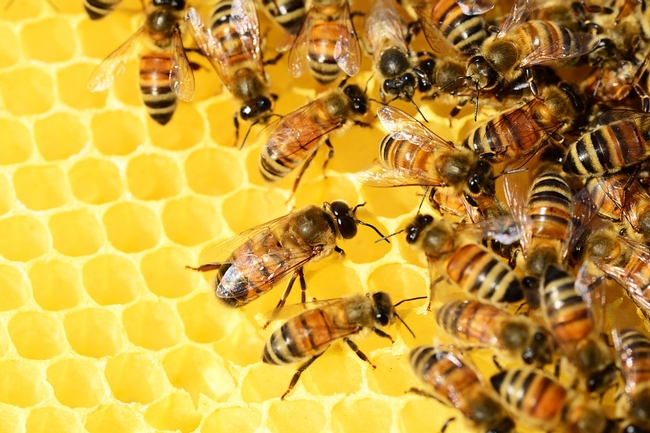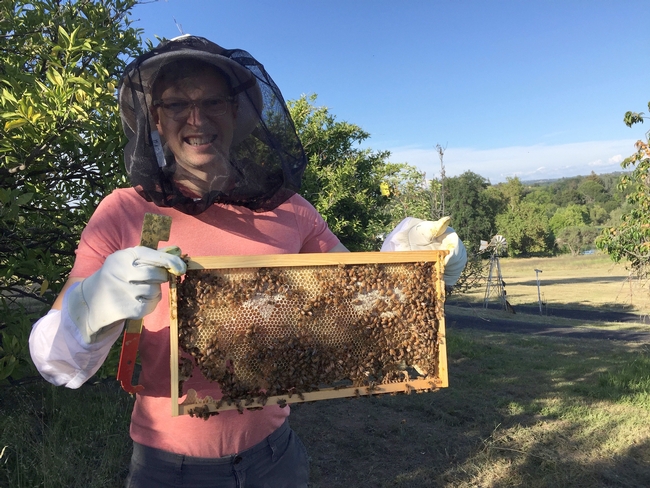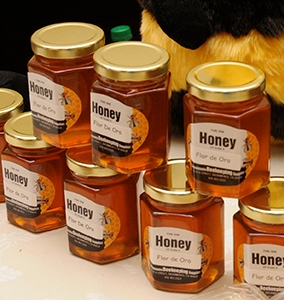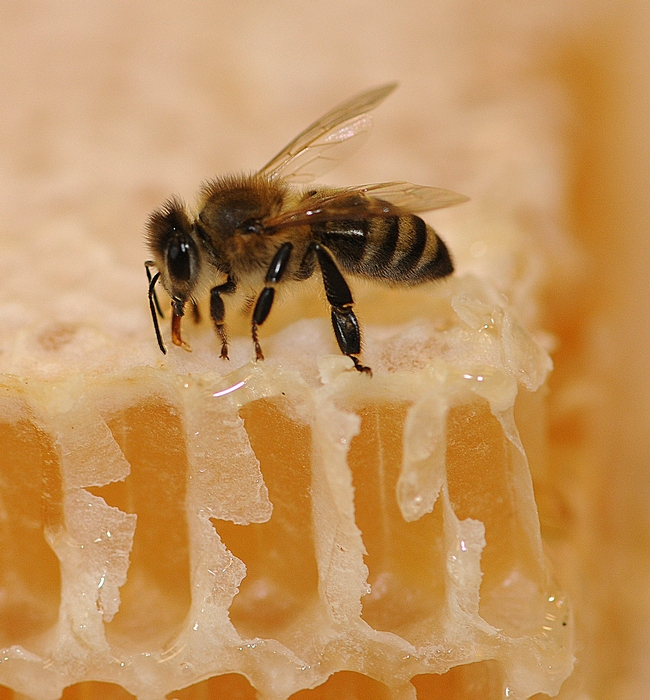Posts Tagged: honey
Honey: Nothing short of miraculous
“Honey, please pass the honey!”
That simple request, prefaced with a term of endearment for good measure, means there's honey on the table.
And well there should be. As the daughter, granddaughter and great-great granddaughter (and beyond) of beekeepers, I grew up with honey on the table. (And on my fingers, face and clothes.)
My favorite then was clover honey from the lush meadows and fields of our 300-acre farm in southwest Washington. My favorite now is Northern California yellow starthistle honey, derived from the blossoms of that highly invasive weed, Centaurea solstitialis, which farmers hate (and rightfully so) and beekeepers love.
“Almost every honey has its own unique flavor-- even when it is the same varietal,” says Amina Harris, director of the UC Davis Honey and Pollination Center. “There are characteristics we learn to look for, but even within that variety, the honey will differ from each area collected. For instance: avocado honey is known for being very dark amber with a flavor reminiscent of molasses, licorice or anise. However, once you start tasting a selection, some will taste like blackstrap molasses and very black licorice. Others will have almost a fruity flavor like dried figs or prunes. Most folks can't tell the difference – and then there are the honey nerds, like me!”
“My favorite all-around honey is one I keep returning to. I love sweet clover from the High Plains with its cinnamon hit —the spicy characteristic is just something I love,” Harris said. “My favorite ‘shock honey' is coriander. Collected near Yuba City, this seed crop gives us a honey that is like walking through a spice bazaar with hints of cardamom, cinnamon, allspice, nutmeg, coriander and — chocolate.”
The UC Davis Honey and Pollination Center, located in the Mondavi Institute for Wine and Food Science on Old Davis Road, periodically offers courses on the sensory evaluation of honey, as well as honey tastings. Next up: the center will host free honey tastings at its home base during the 105th Annual Campuswide Picnic Day on April 13, and at the California Honey Festival in downtown Woodland on May 4. Another popular honey tasting: California Extension apiculturist Elina Lastro Niño, based in the UC Davis Department of Entomology and Nematology, hosts a honey tasting at Briggs Hall during the annual Picnic Day.
There's more to honey than meets the eye — or the palate. The Honey and Pollination Center recently hosted a three-day Sensory Evaluation of Honey Certificate Course last October, using “sensory evaluation tools and methods to educate participants in the nuances of varietal honey,” Harris said. Northern California public radio station KQED spotlighted the course on its “Taste This” program.
And we owe it all to honey bees.
Pollination ecologist Stephen Buchmann of the University of Arizona (who received his doctorate in entomology from UC Davis, studying with native pollinator specialist Robbin Thorp), writes in his book, Honey Bees: Letters from the Hive, that each worker bee “may make four to ten or so flights from the nest each day, visiting hundreds or many thousands of flowers to collect nectar and pollen. During her lifetime, a worker bee may flown 35,000 to 55,000 miles collecting food for her and her nest mates. One pound of honey stored in the comb can represent 200,000 miles of combined bee flights and nectar from as many as five million flowers.”
Take a 16-ounce jar of honey at the supermarket. That represents “the efforts of tens of thousands of bees flying a total of 112,000 miles to forage nectar from about 4.5 million flowers,” writes Buchmann.
Of course, we primarily appreciate honey bees for their pollination services (one-third of the food we eat is pollinated by bees) but honey is more than just an after thought.
It's been described as “liquid gold,” “the nectar of the gods” and “the soul of a field of flowers.” Frankly, it's nothing short of miraculous.
And well it should be.
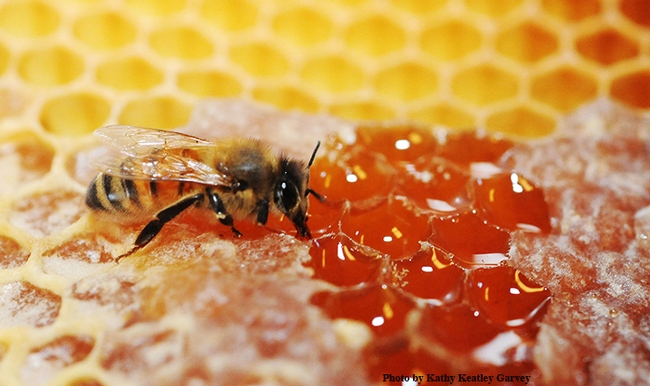
A honey bee sips honey from honeycomb. (Photo by Kathy Keatley Garvey)
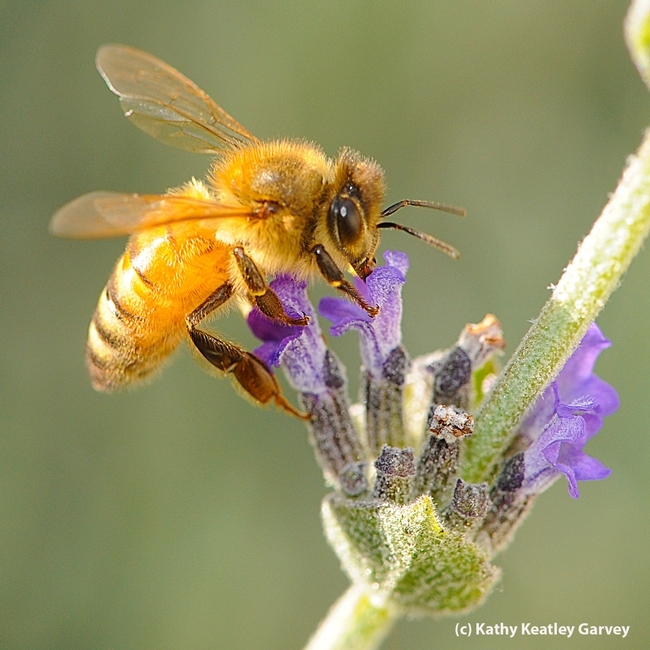
A honey bee sips nectar from a lavender blossom. (Photo by Kathy Keatley Garvey)
Honey bee health key to wellbeing of important species
Our friends the honey bees make it possible for us to devour an abundance of almond products. In 2016 the California almond crop totaled 2.15 billion pounds valued at $5.2 billion. Growing 80 percent of the world's almonds in California takes a lot of honey bees for pollination, roughly two hives for every acre of almond trees. It's estimated that California has 1.3 million acres of almonds, stretching 400 miles between Bakersfield and Red Bluff.
California is rated in the top five honey producing states in the nation. The U.S. per capita consumption of honey is around 1.3 pounds per year. Our buzzing friends visit millions of blossoms, making pollination of plants possible and collecting nectar to bring back to the hive. Lucky for us bees make more honey than their colony needs allowing beekeepers the opportunity to remove the excess honey and bottle it for us to enjoy.
Bees are animals too
Bees are one of our planet's most important animals. They produce honey and they are the primary managed pollinators for a majority of high value specialty crops grown in the contiguous states of California and Oregon, such as nuts, stone fruits, vegetables, and berries. A problem looms for our animal friends, the bees. Colony losses are high due to a variety of environmental and biological causes including bacterial diseases. Historically, beekeepers have self-prescribed antibiotics to control these diseases.
Enter UC Davis and Oregon State University to aid beekeepers in addressing the problem of antibiotic resistance and antimicrobial use in the feed or water of food-producing animals, namely, protecting the health and safety of bees. The overall strategy leads to a safer food supply because the potential for antibiotic resistance is reduced.
The Western Institute for Food Safety and Security (WIFSS), UC Cooperative Extension, and UC Davis School of Veterinary Medicine are partnering with Oregon State University in a USDA funded multi-state specialty crop project to develop CE training for veterinarians on bee health and antibiotic use — a practice that is now regulated under the Veterinary Feed Directive (VFD). The project will offer a comprehensive bee biology online course and train-the-trainer practical training for veterinarians and apiculture educators. The ultimate goals are to protect the specialty crop — honey — from becoming contaminated with antibiotic residues; to protect the health and safety of bees, which are essential to California agriculture; and, finally, to support veterinary oversight in the use of antibiotics, which will lead to an overall reduction of antibiotic resistant bacteria in the environment.
The $483,278 award will address the unique needs of the beekeeping industry that have been experiencing high colony losses since 2006. It will also focus on new rules established by the U.S. Food & Drug Administration on the use of antibiotics which are used to control certain diseases affecting bee colonies.
The principal investigator is Elina L. Niño, a UC Cooperative Extension specialist with the UC Davis Department of Entomology and Nematology. Project leader is Bennie Osburn, director of outreach and training at WIFSS. Collaborating in the project is Jonathan Dear, from the Department of Medicine and Epidemiology at UC Davis School of Veterinary Medicine, and the partner state collaborator is Ramesh Sagili from the Department of Horticulture at Oregon State University. A team of graphic and instructional designers from WIFSS will work with Drs. Niño, Dear, and Sagili, to translate the science into user friendly information for veterinarians and beekeepers.
Educating about honey bee health
Dear who is collaborating with WIFSS to produce an online and hands-on module to train veterinarians about beekeeping and honey bee health, points out that, “Honey bees are such an important part of our economy and, like any food producing animal, they can be affected by preventable and treatable diseases.”
He is enthusiastic about the project and says, “Our hope is that by educating veterinarians about honey bee health, they can play a key role in maintaining the health and wellbeing of this important species.”
With the efforts of extension specialists, veterinarians, and graphic and instructional designers, beekeepers and veterinarians will work together to navigate the VFD regulations, and consumers will continue to enjoy nature's sugar.
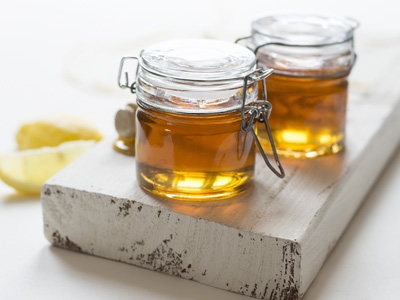
UCANR-Honey-400x300
How to make something sweet even sweeter
It's more than that if you're a beekeeper. It's your pride and joy.
Whether beekeeping is your livelihood, your leisure activity, or something you do to help the declining bee population, that byproduct of your bees--honey--can also be an opportunity for bragging rights.
Entries are now being accepted for the nationwide honey competition sponsored by Good Food Awards.
If you're one of the nation's beekeepers, there's still time to enter your honey, says contest coordinator Amina Harris, director of the UC Davis Honey and Pollination Center.
The deadline to do so is Sunday, July 31. The four subcategories are Liquid and Naturally Crystallized, Creamed, Comb, and Infused Honey.
The contest is divided into five regions--East, South, North, Central and West--with seven or more states assigned to one region, Harris says.
- West: California, New Mexico, Arizona, Hawaii, Nevada, Hawaii and Alaska.
- North: Oregon, Washington, Idaho, Montana, Wyoming, North and South Dakota and Minnesota
- Central: Colorado, Nebraska, Kansas, Missouri, Iowa, Illinois, Wisconsin, Michigan, Indiana, Ohio and Kentucky
- East: Maine, New Hampshire, Vermont, New York, Pennsylvania, Massachusetts, Connecticut, Rhode Island, New Jersey, Maryland and West Virginia
- South: Virginia, North and South Carolina, Tennessee, Georgia, Florida, Alabama, Mississippi, Arkansas, Oklahoma, Louisiana and Texas
"Finalists from each region are selected on a tasting day in September," Harris explains. "They are vetted according to criteria on this page. Winners are selected during the fall months and announced at the end of the year. The awards will be presented in mid-January."
Harris says there are more than 300 unique types of honey in the United States. The Good Food Awards will showcase honeys most distinctive in clarity and depth of flavor, produced by beekeepers practicing good animal husbandry and social responsibility. The honey can come from hives located in numerous places, from rooftops to fields to backyards.
Last year's top awards went to:
- Bee Girl, Bee Girl Honey, Oregon
- Bee Local, Bee Local Sauvie Honey, Oregon
- Bee Squared Apiaries, Rose Honey, Colorado
- Bees' Needs, Fabulous Fall, New York
- Bloom Honey, Orange Blossom, California
- Gold Star Honeybees, Gold Star Honey, Maine
- Hani Honey Company, Raw Creamed Wildflower Honey, Florida
- Mikolich Family Honey, Sage and Wild Buckwheat, California
- MtnHoney, Comb Honey Chunk, Georgia
- Posto Bello Apiaries, Honey, Maine
- Sequim Bee Farm, Honey, Washington
- Simmons Family Honey, Saw Palmetto Honey, Georgia
- Two Million Blooms, Raw Honey, Illinois
- UrbanBeeSF, Tree Blossom Honey Quince & Tree Blossom Honey Nopa, California
To enter the competition, access this page: http://www.goodfoodawards.org/honey/
The Honey and Pollination Center is affiliated with the Robert Mondavi Institute for Wine and Food Science and the UC Davis Department of Entomology and Nematology. For more information, email Harris at aharris@ucdavis.edu.
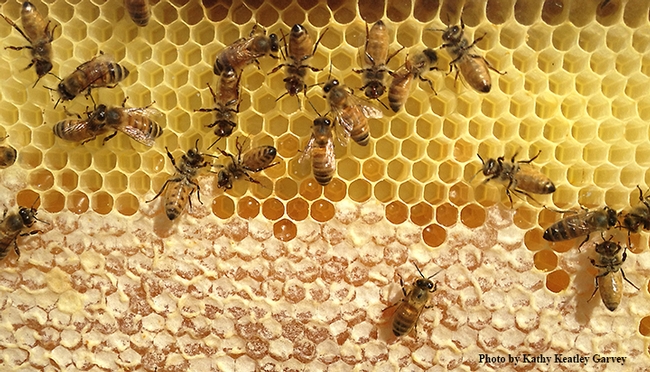
Honey bees in the process of making honey. This photo was taken through a bee observation hive. (Photo by Kathy Keatley Garvey)
Mid-winter feast to celebrate bees and honey
It may be the heart of winter now, but in Central California, spring is just around the corner, bringing with it clouds of pink and white blossoms on thousands of almond trees.
And with the blossoms come the bees on which so many California crops depend for pollination.
In celebration of this vibrant time of year and the bees and beekeepers who help bring it to life, a special five-course gourmet dinner will be held Saturday, Feb. 8, at the Robert Mondavi Institute for Wine and Food Science at UC Davis.
The Mid-Winter Beekeeper’s Feast: A Taste of Mead and Honey is coordinated by the Mondavi Institute’s Honey and Pollination Center as a showcase for local, seasonal foods and a fundraiser for the center.
The dinner, which will be from 6:30 p.m. to 9:30 p.m. in the Sensory Building of the Robert Mondavi Institute, has been designed by UC Davis alumna Ann Evans using her “Davis Farmer’s Market Cookbook” and by Mani Niall, author of numerous cookbooks including “Covered in Honey” and his latest venture, “Sweet!”
Each of the five courses will feature seasonally available foods that are enhanced with varietal honeys, wines and mead. The meal will conclude with a cheese course with fresh honeycomb and a selection of mead. The mead tasting will be guided by Darrell Corti, an international wine judge.
The event will be accompanied by a musical trio and include a silent auction of gift baskets and unique food-, wine- and honey-focused opportunities.
Proceeds from the evening will benefit the Honey and Pollination Center, which coordinates educational and research efforts in support of all aspects of the beekeeping industry.
If you’re interested in joining in this celebration of the bounty of the beehive and beekeepers, visit the events section of the Robert Mondavi Institute website and look for the Mid-Winter Beekeeper’s Feast flyer and registration information, including details for purchasing either single tickets or sponsoring an entire table.
The fruits of their labors
Summer time...and the livin' is easy.
But not for the bees. Worker bees, which live about four to six weeks, literally work themselves to death gathering nectar, pollen, propolis (plant resin) and water to bring back to their colony.
So, when you sit down to summer meals, you can thank a bee.
Extension apiculturist Eric Mussen of the UC Davis Department of Entomology and Nematology, says one-third of the American diet is pollinated by bees. Without bees, we'd be eating such wind-pollinated grains as wheat and rice.
Our gardens and orchards yield such favorites as carrots, cucumbers, onions, apples, grapefruit, oranges, pears, cherries, raspberries, strawberries, blueberries, lima beans, sunflowers and almonds.
All pollinated by honey bees.
Cole crops, such as cabbage, Brussel sprouts, collards, kale, kohlrabi, spinach, chard and broccoli?
All pollinated by honey bees.
Even milk and ice cream are linked closely to the honey bee. Cows feed on alfalfa, which is pollinated by honey bees (along with other bees). Ice cream ingredients usually include fruits and nuts, other bee favorites.
The ever-popular fruit salad features blueberries, apples, oranges and pomegranates.
All pollinated by honey bees.
An apple a day may keep the doctor away, but without the bees, we'd have no apples.
Love apples and honey? Here are two recipes from the National Honey Board celebrating both honey and apples.
Apple honey crisp
2 lbs. apples, quartered and sliced (1-1/2 quarts)
1/2 cup plus 1/4 cup honey, (separated)
1 teaspoon cinnamon
1/2 teaspoon nutmeg
1 cup flour
1/4 cup butter, softened
Warm Nutmeg Cream, (recipe follows) or ice cream
Toss apples with 1/2 cup honey, cinnamon and nutmeg in bowl. Turn into 2-quart baking dish. For topping, beat flour with butter and 1/4 cup honey until crumbly; sprinkle over apples. Bake at 350 degrees for 40 to 45 minutes or until apples are tender and topping is golden. Serve with warm nutmeg cream or ice cream.
Warm nutmeg cream
1/2 cup whipping cream
2 tablespoons honey
2 tablespoons butter
1/4 teaspoon nutmeg
Combine all ingredients in saucepan and bring to boil. Simmer, stirring often, for 5 minutes or until mixture thickens slightly.
Honey apple cake
1/3 cup butter or margarine
1/3 cup packed brown sugar
2 eggs
1/3 cup honey
1 teaspoon grated lemon peel
1-1/2 cups flour
1 teaspoon baking powder
1/2 teaspoon baking soda
1/2 teaspoon ground cinnamon
1/4 teaspoon salt
1/4 teaspoon ground nutmeg
1/8 teaspoon ground allspice
1/4 cup water
1 cup (1 medium) pared, cored, & chopped apple
1/4 cup chopped walnuts
Honey Apple Topping
Cream butter and sugar until light and fluffy. Add eggs, one at a time; beat after each addition. Beat in honey and lemon peel. Combine flour, baking powder, soda, spices and salt; mix well. Add to creamed mixture alternately with water; begin and end with dry ingredients. Stir in apples and nuts. Turn into greased and floured 9-inch heart-shaped or round cake pan. Bake at 325 degrees F. for 45 to 55 minutes or until wooden toothpick inserted near center comes out clean. Cool 10 minutes and remove from pan. Cool completely. Brush top of cake with sauce from honey apple topping; arrange topping on cake.
Honey apple topping
1/3 cup honey
2 tablespoons rosé wine
2 tablespoons lemon juice
2 medium apples
Heat honey, rosé wine and lemon juice. Core and slice 2 medium apples; add to honey. Cook until tender and glazed; turn slices halfway through cooking. Makes topping for one 9-inch cake.
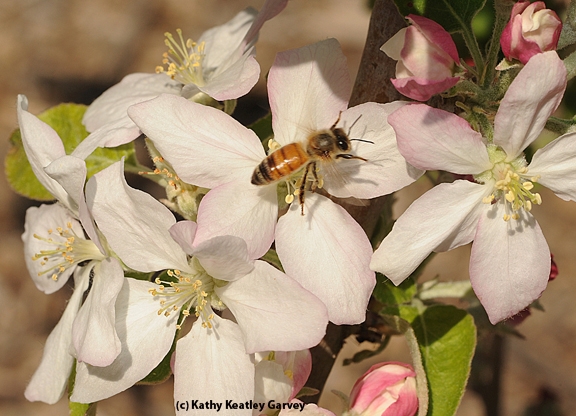
Honey bee pollinating apple blossom. (Photo by Kathy Keatley Garvey)
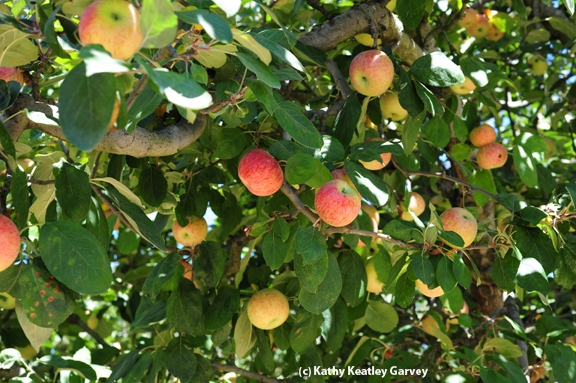
Gravenstein apples ready to be picked. (Photo by Kathy Keatley Garvey)
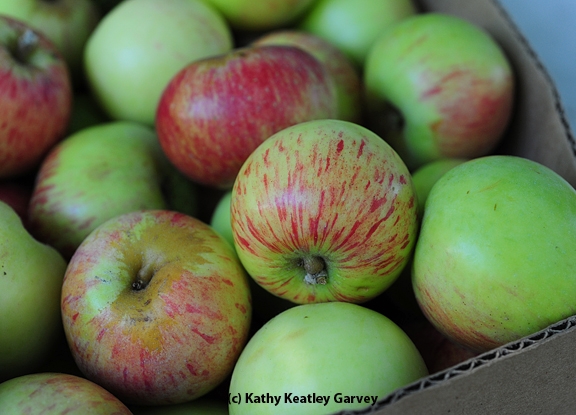
Gravenstein apples ready to eat. (Photo by Kathy Keatley Garvey)


